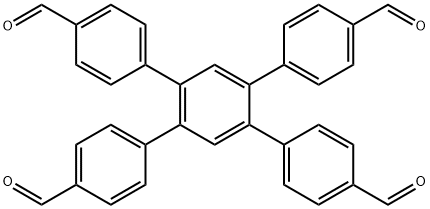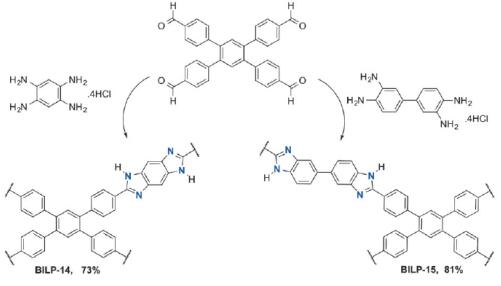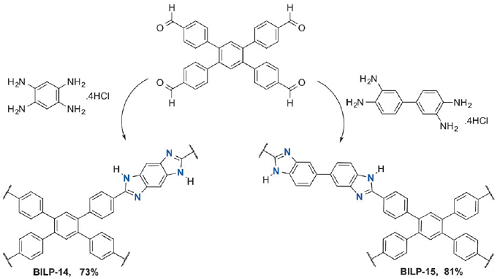1,2,4,5-Tetrakis-(4-formylphenyl)benzene: properties, applications and synthesis
General Description
1,2,4,5-Tetrakis-(4-formylphenyl)benzene is a versatile chemical compound that has gained significant attention due to its potential applications in synthesizing covalent organic frameworks (COFs). COFs are porous, crystalline organic polymers with periodic structures and high surface areas, making them useful for gas storage and separation, heterogeneous catalysis, sensing, optoelectronics, and energy storage. This compound can be synthesized using reagents such as potassium carbonate and solvents including 1,4-dioxane and water. Recent studies have demonstrated the synthesis of isostructural three-dimensional COFs with tailored pore environments for various applications, confirming the potential for this compound in the design and synthesis of COFs. Overall, 1,2,4,5-Tetrakis-(4-formylphenyl)benzene is an important intermediate for the development of COFs with diverse applications.
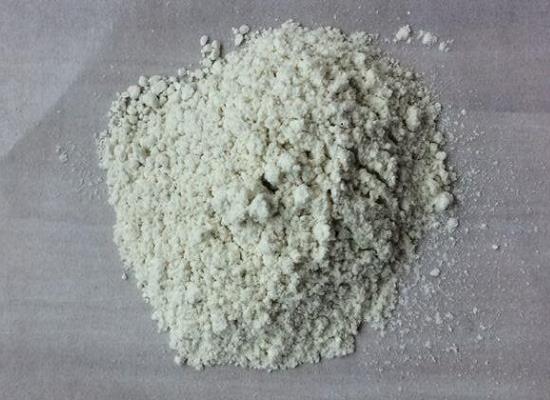
Figure 1. 1,2,4,5-Tetrakis-(4-formylphenyl)benzene
Properties
1,2,4,5-Tetrakis-(4-formylphenyl)benzene is a chemical compound with the molecular formula C34H22O4 and a molecular weight of 494.5 g/mol. It is also known by several synonyms including 4-[2,4,5-tris(4-formylphenyl)phenyl]benzaldehyde. This compound has a complex structure consisting of a central benzene ring with four 4-formylphenyl substituents attached to it. The physical and chemical properties of 1,2,4,5-Tetrakis-(4-formylphenyl)benzene have been calculated and reported by PubChem. It has a high XLogP3-AA value of 6.3 indicating that it is a hydrophobic compound and it demonstrates significant potential for lipophilicity, indicating an affinity for lipid-rich environments. Additionally, it has four hydrogen bond acceptor sites and eight rotatable bonds. The compound has an exact mass and monoisotopic mass of 494.15180918 g/mol and a topological polar surface area of 68.3 Ų. Overall, 1,2,4,5-Tetrakis-(4-formylphenyl)benzene is a highly substituted aromatic aldehyde that can be used in the synthesis of various organic compounds due to its unique structure and reactivity. 1
Applications
1,2,4,5-Tetrakis-(4-formylphenyl)benzene is a versatile organic intermediate that has gained significant attention in recent years due to its potential applications in synthesizing covalent organic frameworks (COFs). COFs are a class of porous, crystalline organic polymers with periodic structures and high surface areas, which make them ideal for various applications. One of the most promising applications of COFs is in gas storage and separation. The high porosity and tunable structures of COFs enable them to selectively adsorb and separate gases such as hydrogen, methane, and carbon dioxide. This makes them highly useful for gas storage and purification in industrial processes and transportation. Additionally, COFs can also be used as heterogeneous catalysts for various chemical reactions. Their unique properties, such as high surface area and tunable structures, make them effective catalysts for reactions such as oxidation, reduction, and alkene epoxidation. This has potential applications in the production of fine chemicals and pharmaceuticals. COFs also have great potential in sensing and optoelectronics due to their inherent porosity and tunable properties. For example, COFs can be utilized as fluorescent sensors for detecting small molecules or as photoactive materials for solar energy conversion. This makes them promising candidates for use in sensors, electronics, and renewable energy technologies. In conclusion, 1,2,4,5-Tetrakis-(4-formylphenyl)benzene is an important organic intermediate with promising applications in the synthesis of COFs. The unique properties of COFs make them useful for gas storage and separation, heterogeneous catalysis, sensing, optoelectronics, and energy storage, among others. 2
Synthesis
1,2,4,5-Tetrakis-(4-formylphenyl)benzene is a compound that can be synthesized using reagents such as potassium carbonate, catalysts like tetrakis(triphenylphosphine)palladium and solvents including 1,4-dioxane and water. The synthesis process takes place over three days at a temperature of 90°C which is then lowered to room temperature. This compound is of interest due to its potential use in the design and synthesis of isostructural three-dimensional covalent organic frameworks (3D COFs). In a recent study, three isostructural 3D COFs were synthesized with substituents -H, -Me or -F which demonstrated similar crystallinity and topology. The crystal structures of these COFs were determined by continuous rotation electron diffraction (cRED) which allowed for the localization of all non-hydrogen atoms directly by 3D ED techniques for the first time. These COFs also exhibited different selectivities for CO2 over N2 depending on the functional groups used. This study confirms that polycrystalline COFs can be studied at the atomic level like other materials, and offers potential for the design and synthesis of 3D COFs with tailored pore environments for various applications. 3
Reference
1. 4-[2,4,5-Tris(4-formylphenyl)phenyl]benzaldehyde. National Center for Biotechnology Information, 2023, PubChem Compound Summary for CID 4277661.
2. Gao C, Li J, Yin S, Lin G, Ma T, Meng Y, Sun J, Wang C. Isostructural Three-Dimensional Covalent Organic Frameworks. Angew Chem Int Ed Engl. 2019 Jul 15;58(29):9770-9775.
3. Li Y, Guo L, Lv Y, Zhao Z, Ma Y, Chen W, Xing G, Jiang D, Chen L. Polymorphism of 2D Imine Covalent Organic Frameworks. Angew Chem Int Ed Engl. 2021 Mar 1;60(10):5363-5369.
Related articles And Qustion
See also
Lastest Price from 1,2,4,5-Tetrakis-(4-formylphenyl)benzene manufacturers
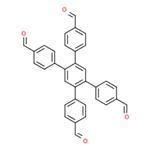
US $10.00-50.00/KG2025-06-18
- CAS:
- 883835-33-4
- Min. Order:
- 1KG
- Purity:
- 99%
- Supply Ability:
- g-kg-tons, free sample is available
